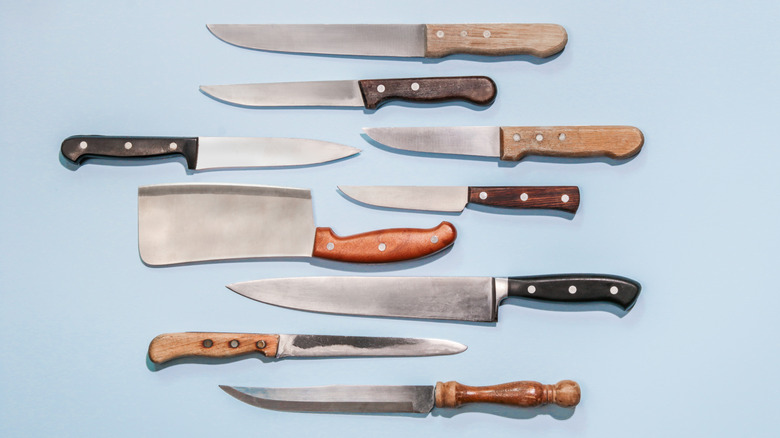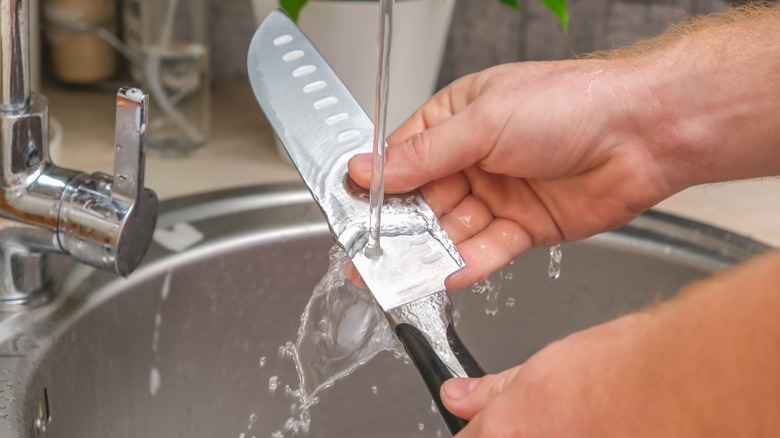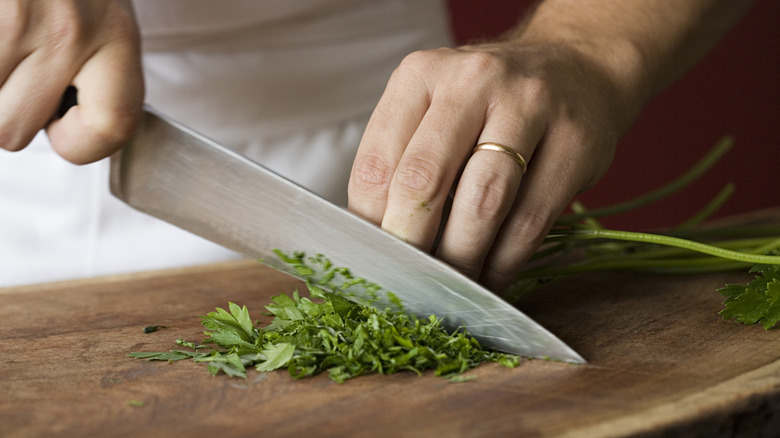A Chef Explains How To Keep Your Knives In Top Shape
If you want to get serious about cooking, your first step should be getting your hands on a high-quality knife. A good knife is arguably more valuable and versatile than any other cooking tool, and observing a cook's knife technique is a surefire way to parse the pros from the novices. There are many varieties of kitchen knives, all tailored to their own unique purposes, but the most essential is a chef's knife, which can handle many different tasks. High-quality chef's knives typically run between $100 to $200, but this investment can last you close to a lifetime if you keep your knife in good condition.
Improperly maintaining your kitchen knives can have serious consequences, from dull blades that can cause injury to rust that can spoil your meal. To gain an expert's input on knife maintenance, Chowhound spoke to chef James Dumapit of Bar Miller in New York City. When it comes to keeping knives in tip-top shape, he emphasizes one thing above all. You've got to wash your knife properly, and it doesn't work like other utensils.
Wash your knives (and more importantly, dry them)
You're probably used to saving the dishes for after dinner, but when it comes to kitchen knives, you've got to clean them right away. This shouldn't take more than a couple of minutes, according to James Dumapit. He says that "Home cooks can clean most knives with warm soapy water and a towel."
The real key here is drying the knife, which should be done the moment you wash it. "You want to keep your knife dry, especially if it's a high carbon knife, as they're prone to rust," Chef Dumapit explains. Even stainless steel knives, which have an additional protective layer, can develop rust stains over time. Since rusting is a chemical reaction between iron and oxygen in the presence of moisture, it is essential that you keep your knife dry whenever you are not actively using it. This means you should never, ever put a kitchen knife in the drying rack, where it will sit with its dampness, but rather dry it immediately after washing with a towel.
If your knife does develop rust, it's not the end of the world. The trace amounts of rust on your knife are too minimal to present a health risk in your food, but rusty knives are much harder to work with. Rust can create an uneven surface on the blade and make the knife duller overall, which means you're more likely to cut yourself.
Only use kitchen knives to cut food
Knife maintenance will be exponentially easier if you use your knife properly, that is to say, using it for its intended purpose only. "The biggest mistake people make with knives," warns James Dumapit, "is misusing them." Using your kitchen knives for any task other than cutting food can cause serious damage that makes maintenance a nightmare.
Don't use kitchen knives for tasks they weren't made to do, such as cutting open packages or trying to cut through frozen food (unless you're the Incredible Hulk, you won't be able to do it anyway). Of all the possible ways to misuse a kitchen knife, there's one in particular that Chef Dumapit has seen quite enough of. "Don't open cans with your kitchen knives. That's cringeworthy."
The final key to knife maintenance is proper storage, for which Dumapit recommends a knife sheath. You could also use a magnetic knife bar or a roll bag, but steer clear of knife blocks. Not only do they force you to buy extra tools that you may not need, but the slots in the block can harbor bacteria. And of course, to ensure proper performance, you should sharpen your knives often and always test that your knives are sharp before using them.


